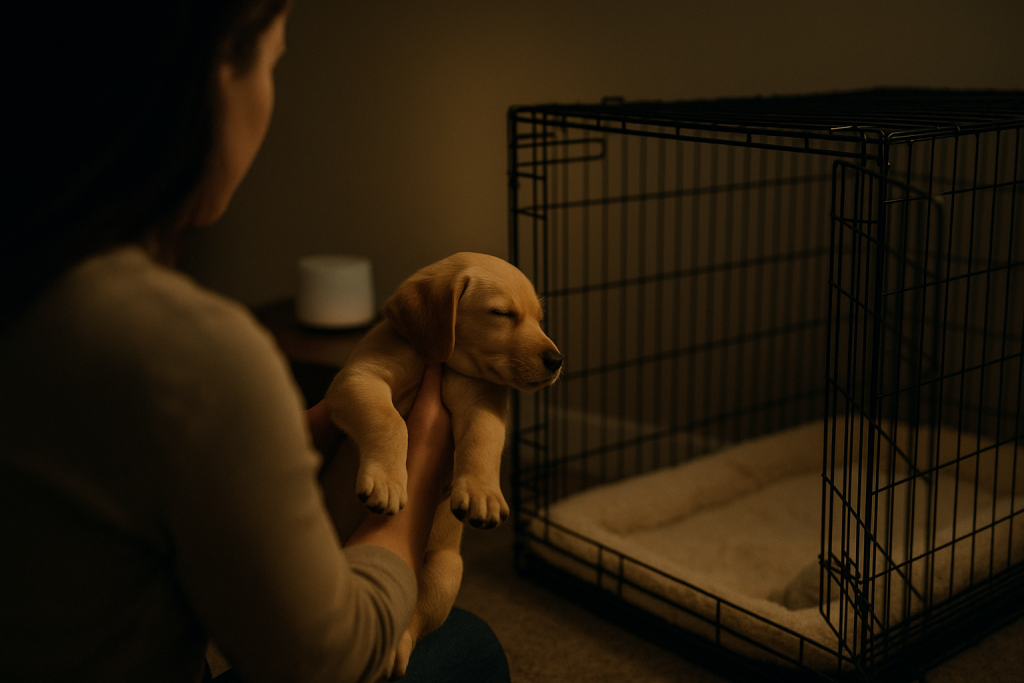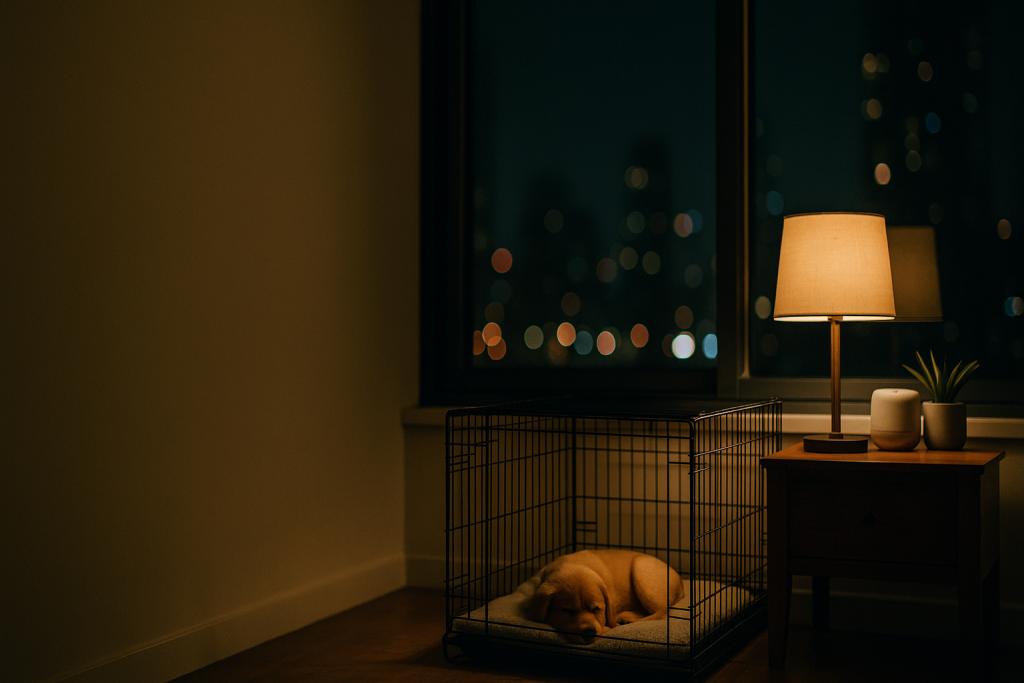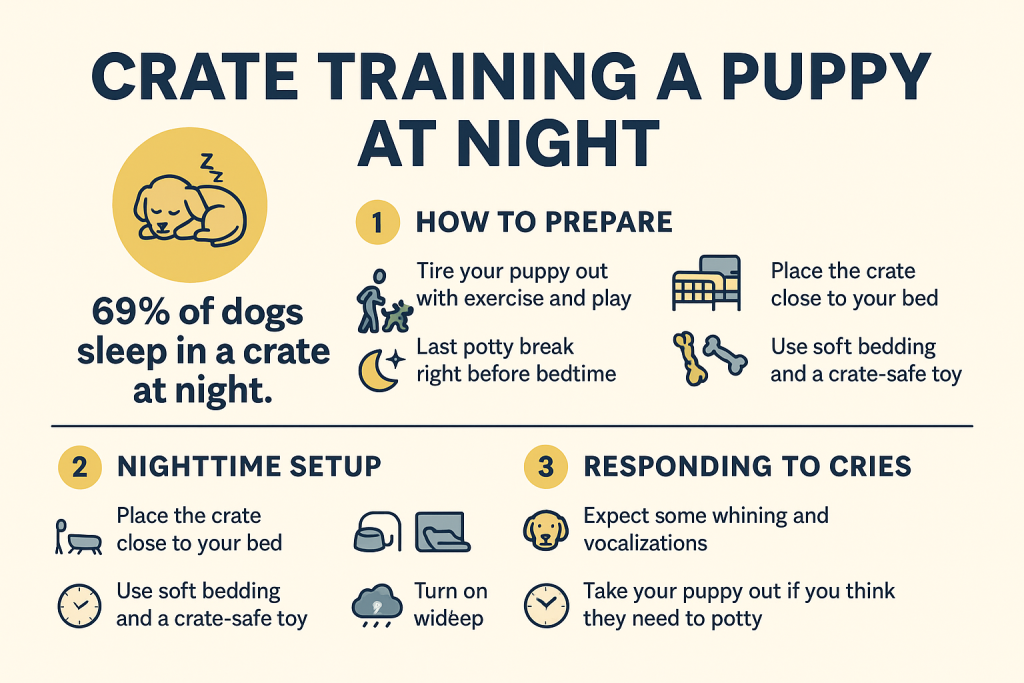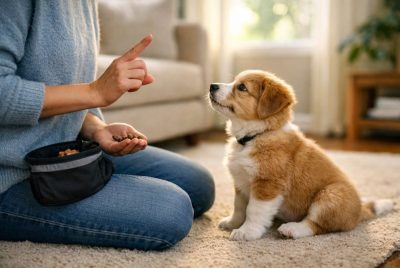Crate Training a Puppy at Night: The Gentle, Get-Sleep Guide
We may earn a commission for purchases made using our links. Please see our disclosure for more details.
You brought home a tiny tornado who naps all day and parties at 2 a.m., right? I’ve been there—listening to soft whimpers, doing “potty math,” wondering if the crate is kind or cruel. Good news: when you introduce it the right way, crate training a puppy at night is a loving, safe, and sanity-saving routine. In this guide, you’ll learn how to set up the right crate, ease nighttime crying, plan potty breaks, use calming tools, and build a bedtime rhythm that actually sticks.
Why Crate Training at Night Works (and Why It’s Kind)
A crate is a puppy’s bedroom: predictable, cozy, and safe. Reward-based introductions help pups relax, sleep longer, and learn bladder control without accidents. Leading behavior organizations recommend positive, rewards-first methods—which is exactly how we’ll do this.
The Sleep Science Behind Calmer Nights
Puppies need a lot of sleep—about 11 hours in 24 hours at ~16 weeks on average, with many needing more. Protecting those hours with a calm, den-like space reduces overstimulation and fussing.
Sleep and Separation: Prevent Problems Early
A 2024 veterinary summary highlights that giving puppies 9+ hours of night sleep in a crate or puppy-safe room and avoiding aversive responses can help prevent separation-related behaviors later. Translation: a kind, consistent nighttime routine now pays off for adult life.
Choose the Right Crate (Size, Type, Location)
- Size: Big enough to stand, turn, lie stretched out—but not a playroom. Use a divider for growing pups.
- Type: Wire crates (more airflow/visibility) vs. plastic/“vari” kennels (cozier, travel-friendly).
- Location: Start near your bed for night training. Being close reduces anxiety and helps you hear early “potty please” whines.
For general veterinary guidance on crate benefits during housetraining, UC Davis offers a concise overview.
Make the Crate a Happy Place (Daytime Foundations)
- Feed meals inside.
- Scatter treats in the bedding.
- Short, sweet “crate games” with open-door chill time.
- End sessions before your pup wants out—success builds confidence.
This lines up with reward-focused, humane training best practices.

First-Night Routine (A Simple Walkthrough)
- Late-evening potty outside (calm praise, no zoomies).
- Wind-down: gentle chew, soft petting, lights lower.
- Into crate with a high-value chew and a bedtime cue (“Crate, sleepy time”).
- Lights out: white noise can help.
- Expect a potty break 3–4 hours later (you’ll stretch this over time).
Night holds for puppies: hour-by-hour
A loose rule is months of age ≈ hours of bladder hold, but that’s the sunny-day formula. Many 8-week-old puppies still need 2–3 night breaks. Prioritize success > strict math; reinforcing clean nights is the goal.
The Nighttime Potty Break (Do It Like a Ninja)
- Quietly carry pup to the potty spot.
- No play, no chatter, no phone flashlight dance.
- Praise for peeing/pooping, then back to bed.
- If nothing happens in 5 minutes, return to crate and try again in 45–60 minutes.
Night Crate Crying: What’s Considered Normal?
Short protest whines are common at first. If the whine escalates or repeats after you’ve already potty-checked, try:
- Gentle shushing or a calm “you’re safe” (no bright lights).
- A heartbeat snuggle aid (see picks below).
- Double-check comfort (drafts, too warm/cold, too much visibility).
Remember, no punishment—aversive responses can increase anxiety.
Comfort Setup: Bedding, Temperature, Sound
- Use a washable crate pad and keep an extra on standby.
- Keep the room cool, dark, and quiet—a small fan or white noise helps steadiness.
- For joint support as your pup grows, bookmark this guide to supportive, orthopedic dog beds for when you transition beyond the crate—see our take on vet-friendly orthopedic dog beds for ideas.
Crate Covers: Den Vibes on Demand
Some pups settle faster when the crate feels like a den (covered on three sides). Others prefer seeing the room. Try both and watch your puppy’s body language. A cover can reduce light/stimuli and support deeper sleep.
The Two-Week Night Plan (A Quick Schedule)
- Nights 1–3: Crate by bed; potty at bedtime + 3 hours later + early morning.
- Nights 4–7: Stretch first break by 30–45 minutes if nights are dry.
- Week 2: Most healthy pups manage 1 break or occasionally none.
- Keep alarms proactive the first week—don’t wait for frantic crying.
Gentle Daytime Habits That Help Nights
- Predictable nap, play, potty cycles.
- Quick, rewarding crate moments during daytime
- Enrichment: sniff walks, food puzzles, training micro-sessions. Better daytime rhythm = easier night sleep.
Mistakes People Make (and How to Dodge Them)
- Punishing your puppy with crate time
- Skipping daytime crate practice.
- Letting late-night potty breaks become play parties.
- Overfeeding or late-heavy water right before bed.
Troubleshooting: If Nights Are Still Tough
- Accidents? Reduce water 2 hours before bed, add one more potty, check crate size.
- Panicked crying? Move crate closer to you temporarily; use a heartbeat toy; shorten pre-bed excitement.
- Multiple wet nights? Schedule a vet chat to rule out UTI or GI issues.

🔹 Amazon Picks: Nighttime Crate Training Essentials
Below are five widely used, practical tools that pair beautifully with a positive nighttime plan.
1) MidWest Homes for Pets iCrate Folding Dog Crate (with Divider)
A classic wire crate with secure latches and a divider so you size it “just right” as your puppy grows.
Features: fold-flat, leak-proof pan, slide-bolt latches with “Paw Block.”
Pros: breathable, adjustable space; easy cleaning.
Cons: more exposure than plastic (some pups need a cover).
Best for: most households needing airflow and flexibility.
Review snapshot: Owners praise the sturdy latches and divider; occasional comments note metal rattling on uneven floors.
Consider the MidWest iCrate if you want adaptability from puppyhood to adolescence.
2) Petmate Vari Kennel (Plastic)
Cozy, travel-friendly “den” feel; great for dogs who relax with less visual stimulation.
Features: durable plastic, ventilation windows, travel-use design.
Pros: naturally darker/quiet-feel; handy for car or flights (check airline rules).
Cons: bulkier; less adjustable than wire.
Best for: sensitive sleepers who settle in darker spaces.
Review snapshot: Fans love the solid, enclosed feel; a few note sizing runs small—measure carefully.
3) SmartPetLove Original Snuggle Puppy Heartbeat Toy
The “sleep buddy” many pups adore—simulated heartbeat and warmth can ease first-night jitters.
Features: pulsing heartbeat (8 or 24 hrs), heat pack pocket.
Pros: reduces loneliness and crying for many puppies.
Cons: not every pup cares; replaceable heat packs.
Best for: new puppies adjusting to solo sleep.
Review snapshot: Tons of stories about first silent nights; occasional feedback about pups ignoring it.
4) K&H Pet Products Self-Warming Crate Pad
Cozy, no-electric warmth using your pup’s own body heat; machine washable.
Features: self-warming layer, non-slip back, multiple sizes.
Pros: safer than plug-in heat, easy to launder.
Cons: not a chew mat; add a cover if your pup is a shredder.
Best for: chilly rooms and small breeds that like warmth.
Review snapshot: Appreciated for gentle warmth and fit in standard crates; a few buyers want thicker cushioning.
5) Amazon Basics Puppy Training Pads (for nearby potty zone)
Useful outside the crate in an attached pen for young pups who can’t yet hold it all night.
Features: multi-layer absorbency, leakproof lining, odor-control carbon option.
Pros: quick cleanup during the first weeks; great safety net.
Cons: can slow house training if overused; keep pads not inside the crate.
Best for: apartment dwellers, very young pups, rainy-night “oops” plans.
Review snapshot: Owners like the absorbency and built-in attractant; some prefer eco options after the early weeks.
Quick Comparison
| Model / Item | Key Spec(s) | Warranty | Approx Price/Tier | Best For |
| MidWest iCrate (wire) | Divider, Paw-Block latches, fold-flat | Varies by seller | $–$$ | Most puppies; adjustable size |
| Petmate Vari Kennel (plastic) | Durable shell, vented sides | Varies | $$ | Travel & “den” sleepers |
| Snuggle Puppy | Heartbeat module, heat-pack pocket | Varies | $$ | Soothing first nights |
| K&H Self-Warming Pad | No-electric warmth, machine washable | Varies | $–$$ | Cozy, drafty rooms |
| Amazon Basics Pads | 5-layer absorbency, odor control option | — | $ | Adjacent potty zone (not inside crate) |
Prices and warranties vary by size and retailer; check listings.

Research-Backed Confidence Boost
- Reward-based training protects welfare—and works. The American Veterinary Society of Animal Behavior’s Position Statement on Humane Dog Training (2021) recommends reward-based methods as the most effective and least harmful approach. In other words, your nighttime crate routine should feel safe and positive, not punishing.
- Sleep matters for future behavior. A 2024 analysis of early-life factors linked to separation-related problems found lower risk when puppies had ~9 or more hours of nighttime sleep and owners avoided aversive methods. See the open-access paper Canine separation-related behaviour at six months of age (2024) and this clear lay summary in Veterinary Practice.
Helpful read: For a practical, step-by-step walkthrough on first nights, crying, and accident-proof routines, check Preventive Vet’s guide to crate training your puppy at night.
A Calming Bedtime Checklist
- Last food 3–4 hours before lights-out; water taper in last 2 hours.
- Slow sniff-walk > potty > crate with a safe chew.
- White noise on; room slightly cool; lights low.
- Plan one proactive potty alarm for week one.
- Morning: out of crate → straight to potty → big praise.
FAQs
What if my puppy cries in the crate at night but just went potty?
Wait 1–2 minutes to see if it settles. Offer a calm, brief reassurance (no lights). If it escalates for 5+ minutes, do a quiet potty check. Return to bed with zero play. Consistency is what teaches “nighttime = sleepy time.”
Should I put puppy pads inside the crate?
Generally, no—pads can blur the “sleep space” vs. “toilet space.” Instead, attach an exercise pen to the crate and keep a pad in the pen area for the first weeks if your pup truly can’t hold it yet.
Is a crate cover necessary?
Not always. Some puppies settle better with a darker den; others prefer a view. Test both. A fitted cover can reduce stimulation and barking for certain pups.
Can puppies sleep through the night at 8 weeks?
A few do, but many need 1–2 breaks. You’ll gradually stretch the first break and fade the second. By 12–16 weeks, lots of pups manage one or no night breaks if daytime routines are solid.
Are crates humane?
Yes—when introduced with positive reinforcement and used for short, appropriate durations. They help house training, protect puppies from nighttime mischief, and create a safe sleep zone. Punishment or excessive confinement is not humane.
Final Pep Talk: You’ve Got This
You’re building two beautiful habits: rest and trust. With a right-sized crate, cozy setup, predictable potty plan, and loads of praise, your puppy learns “nights are safe and boring.” Meanwhile, you finally get to sleep like a human again. Give it two consistent weeks—you’ll be amazed at the progress. And when you’re ready to upgrade comfort outside the crate, explore supportive options like orthopedic dog beds for healthy joints.
Sleep well, friend. You’re doing great.




